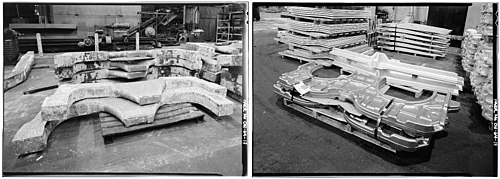
Grafton is a town in Worcester County, Massachusetts, United States. The population was 19,664 at the 2020 census. The town consists of the North Grafton, Grafton, and South Grafton geographic areas, each with a separate ZIP Code. Incorporated in 1735, the town is home to a Nipmuc village known as Hassanamisco Reservation, the Willard House and Clock Museum, Community Harvest Project, and the Tufts University Cummings School of Veterinary Medicine. Grafton operates the state's largest on-call fire department, with 74 members.

Forging is a manufacturing process involving the shaping of metal using localized compressive forces. The blows are delivered with a hammer or a die. Forging is often classified according to the temperature at which it is performed: cold forging, warm forging, or hot forging. For the latter two, the metal is heated, usually in a forge. Forged parts can range in weight from less than a kilogram to hundreds of metric tons. Forging has been done by smiths for millennia; the traditional products were kitchenware, hardware, hand tools, edged weapons, cymbals, and jewellery.

An Aluminum can is a single-use container for packaging made primarily of aluminum. It is commonly used for food and beverages such as olive and soup but also for products such as oil, chemicals, and other liquids. Global production is 180 billion annually and constitutes the largest single use of aluminum globally.
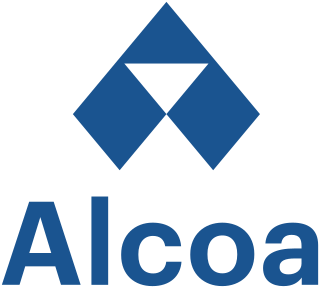
Alcoa Corporation is a Pittsburgh-based industrial corporation. It is the world's eighth-largest producer of aluminum. Alcoa conducts operations in 10 countries. Alcoa is a major producer of primary aluminum, fabricated aluminum, and alumina combined, through its active and growing participation in all major aspects of the industry: technology, mining, refining, smelting, fabricating, and recycling.

Extrusion is a process used to create objects of a fixed cross-sectional profile by pushing material through a die of the desired cross-section. Its two main advantages over other manufacturing processes are its ability to create very complex cross-sections; and to work materials that are brittle, because the material encounters only compressive and shear stresses. It also creates excellent surface finish and gives considerable freedom of form in the design process.
Compass Minerals International, Inc is a public company that, through its subsidiaries, is a leading producer of minerals, including salt, magnesium chloride and sulfate of potash. Based in Overland Park, Kansas; the company provides bulk treated and untreated highway deicing salt to customers in North America and the United Kingdom and plant nutrition products to growers worldwide. Compass Minerals also produces consumer deicing and water conditioning products, consumer and commercial culinary salt, and other mineral-based products for consumer, agricultural and industrial applications. In addition, Compass Minerals provides records management services to businesses throughout the United Kingdom.
Kaiser Aluminum Corporation is an American aluminum producer. It is a spinoff from Kaiser Aluminum and Chemicals Corporation, which came to be when common stock was offered in Permanente Metals Corporation and Permanente Metals Corporation's name was changed to Kaiser Aluminum and Chemicals Corporation.
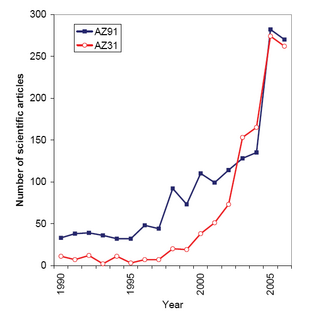
Magnesium alloys are mixtures of magnesium with other metals, often aluminium, zinc, manganese, silicon, copper, rare earths and zirconium. Magnesium alloys have a hexagonal lattice structure, which affects the fundamental properties of these alloys. Plastic deformation of the hexagonal lattice is more complicated than in cubic latticed metals like aluminium, copper and steel; therefore, magnesium alloys are typically used as cast alloys, but research of wrought alloys has been more extensive since 2003. Cast magnesium alloys are used for many components of modern automobiles and have been used in some high-performance vehicles; die-cast magnesium is also used for camera bodies and components in lenses.

An aluminium alloy (UK/IUPAC) or aluminum alloy is an alloy in which aluminium (Al) is the predominant metal. The typical alloying elements are copper, magnesium, manganese, silicon, tin, nickel and zinc. There are two principal classifications, namely casting alloys and wrought alloys, both of which are further subdivided into the categories heat-treatable and non-heat-treatable. About 85% of aluminium is used for wrought products, for example rolled plate, foils and extrusions. Cast aluminium alloys yield cost-effective products due to the low melting point, although they generally have lower tensile strengths than wrought alloys. The most important cast aluminium alloy system is Al–Si, where the high levels of silicon (4–13%) contribute to give good casting characteristics. Aluminium alloys are widely used in engineering structures and components where light weight or corrosion resistance is required.
Aluminium–lithium alloys are a set of alloys of aluminium and lithium, often also including copper and zirconium. Since lithium is the least dense elemental metal, these alloys are significantly less dense than aluminium. Commercial Al–Li alloys contain up to 2.45% lithium by mass.
6061 aluminium alloy is a precipitation-hardened aluminium alloy, containing magnesium and silicon as its major alloying elements. Originally called "Alloy 61S", it was developed in 1935. It has good mechanical properties, exhibits good weldability, and is very commonly extruded. It is one of the most common alloys of aluminium for general-purpose use.

In the automotive industry, alloy wheels are wheels that are made from an alloy of aluminium or magnesium. Alloys are mixtures of a metal and other elements. They generally provide greater strength over pure metals, which are usually much softer and more ductile. Alloys of aluminium or magnesium are typically lighter for the same strength, provide better heat conduction, and often produce improved cosmetic appearance over steel wheels. Although steel, the most common material used in wheel production, is an alloy of iron and carbon, the term "alloy wheel" is usually reserved for wheels made from nonferrous alloys.

Kamensk-Uralsky Metallurgical Works J.S.Co. (KUMZ) is one of the town-forming enterprises of Kamensk-Uralsky, Sverdlovsk Oblast, Russia. KUMZ was founded especially for supplying of aerospace industry with semi-finished products in aluminium and magnesium alloys. Currently, the plant produces aluminium alloy billets, forged and rolled plates, roll bond heat exchangers, extruded rods, bars, tubes, drill pipes, profiles, die-forgings.
The Aluminum Association is a trade association for the aluminum production, fabrication and recycling industries, and their suppliers. The Association is a 501(c)(6) non-profit organization based in Arlington, Virginia, United States.
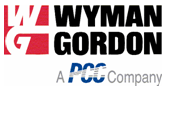
Wyman-Gordon is a company that designs and manufactures complex metal components. Founded in 1883 as a manufacturer of crankshafts for looms, it has a long history of making forged metal components, particularly for the aerospace industry. Wyman-Gordon is a wholly owned subsidiary of Precision Castparts Corp., and is based in Houston, Texas. It has thirteen (13) plants in five countries, and employed about 2,500 people as of 2012.
Wyman-Gordon Grafton Plant, formerly known as Air Force Plant 63, is a plant of Wyman-Gordon located in North Grafton, Massachusetts. It was purchased by Wyman-Gordon in 1982 from the United States Air Force, although the company had been operating as a contractor for the plant since its establishment. The plant is also home to the one of two of the nation's largest forging presses.
Mesta Machinery was a leading industrial machinery manufacturer based in the Pittsburgh area town of West Homestead, Pennsylvania. It was founded in 1898 by George Mesta when he merged his machine shop with another. Mesta "machines" can be found in factories throughout the world and as of 1984 had equipment in 500 steel mills. Mesta was the 488th largest American company in 1958 and the 414th largest in 1959.
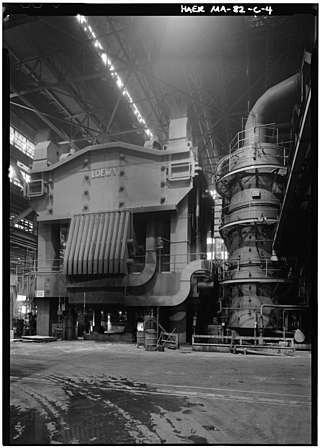
The Wyman-Gordon 50,000-ton forging press is a forging press located at the Wyman-Gordon Grafton Plant that was built as part of the Heavy Press Program by the United States Air Force. It was manufactured by Loewy Hydropress of Pittsburgh, Pennsylvania and began operation in October, 1955.
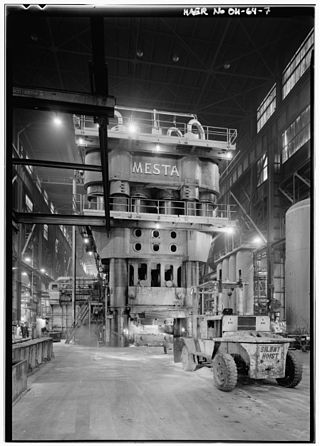
The Alcoa 50,000 ton forging press is a heavy press operated at Howmet Aerospace's Cleveland Operations. It was built as part of the Heavy Press Program by the United States Air Force. It was manufactured by Mesta Machinery of West Homestead, Pennsylvania, and began operation on May 5, 1955.
Aluminium–copper alloys (AlCu) are aluminium alloys that consist largely of aluminium (Al) and traces of copper (Cu) as the main alloying elements. Important grades also contain additives of magnesium and silicon, often manganese is also included to increase strength. The main area of application is aircraft construction. The alloys have medium to high strength and can be age-hardened. They are both wrought alloy. Also available as cast alloy. Their susceptibility to corrosion and their poor weldability are disadvantageous.


